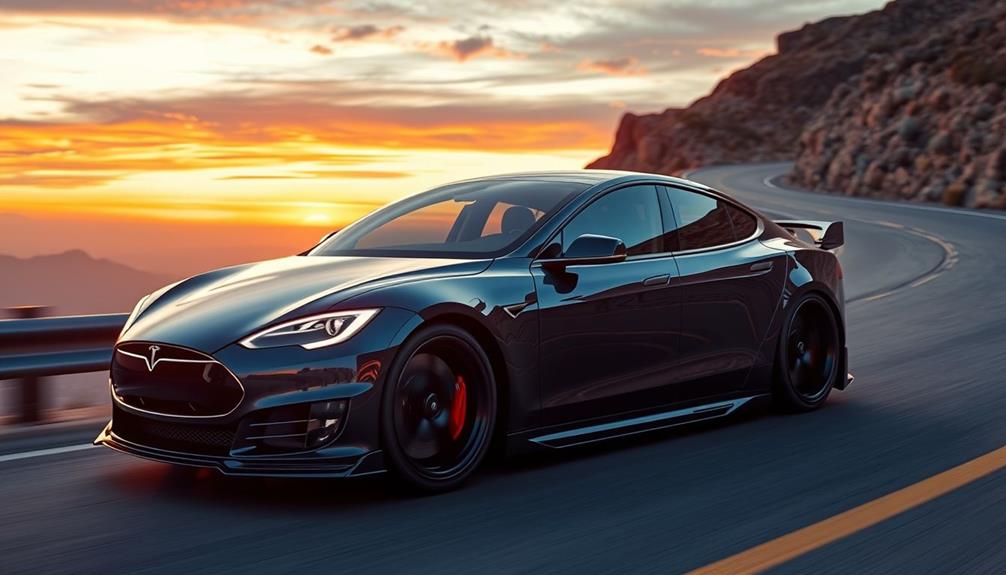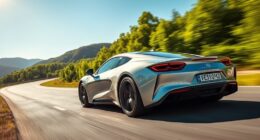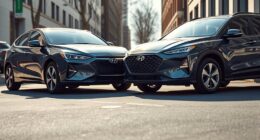Tesla's Full Self-Driving (FSD) enhances your driving experience with features like Autopark and Smart Summon, yet it still requires your full attention. Classified as SAE Level 2, FSD can guide your car but demands constant supervision to guarantee safety. While pricing options include a one-time fee of $8,000 or a $99 monthly subscription, many users find its performance inconsistent, especially in heavy traffic. You'll need to weigh the benefits against the risks of overconfidence and potential safety issues. If you're curious about how it all fits together, there's more to explore about FSD's capabilities and user experiences.
Key Takeaways
- Full Self-Driving (FSD) is an optional Tesla feature that enhances Autopilot but requires constant driver supervision and is classified as SAE Level 2.
- FSD includes features like Navigate on Autopilot, Autopark, and Smart Summon, designed to aid navigation and parking.
- Users can choose between a monthly subscription of $99 or a one-time payment of $8,000, with a free 30-day trial for eligible vehicles.
- Performance can decline in heavy traffic and complex environments, often leading to erratic behavior that requires immediate human intervention.
- While FSD offers advanced capabilities, concerns about overconfidence and safety risks highlight the importance of responsible use and driver attentiveness.
Understanding Full Self-Driving

Understanding Full Self-Driving (FSD) can feel overwhelming, but it's simpler than it seems. Full Self Driving is an optional feature you can add to your Tesla, enhancing the standard Autopilot system with advanced driver assistance capabilities. Classified as SAE Level 2, FSD requires your supervision at all times, ensuring you're always in control.
The system uses Tesla Vision, relying on a network of cameras to assess your surroundings. This camera-only approach, adopted since 2021, allows your vehicle to navigate complex environments, manage traffic lights, and perform lane changes with impressive accuracy.
FSD features like Navigate on Autopilot and Auto Lane Change help you maneuver through busy roads and assist with parking.
You might consider the subscription price of FSD at $99 per month or a one-time payment of $8,000. If you're unsure, Tesla offers a free 30-day trial for eligible vehicles, letting you evaluate its capabilities without financial commitment.
Continuous software updates enhance FSD functionality, fixing issues like phantom braking and improving performance, although limitations can still arise in heavy traffic and complex urban settings.
Key Features of FSD
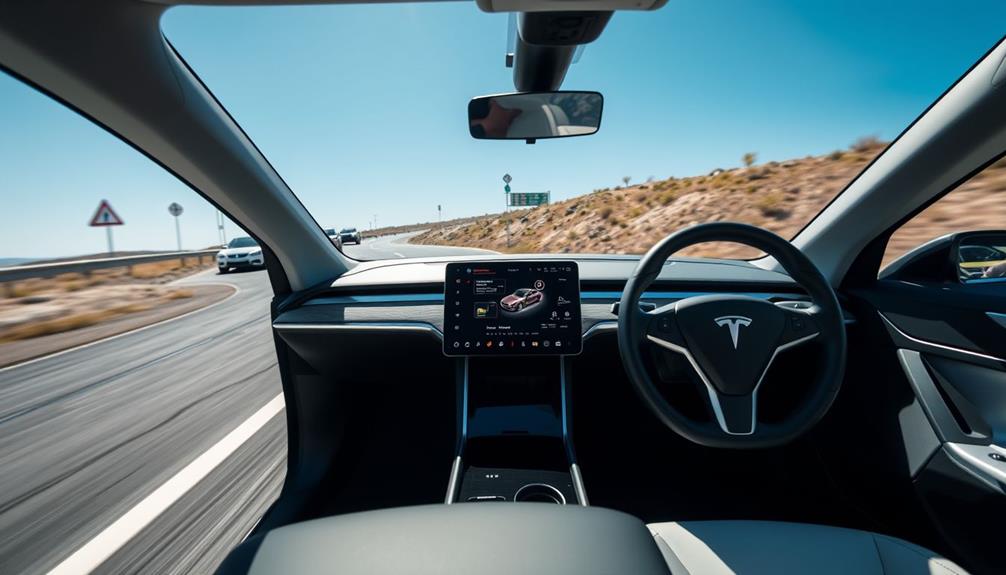
When you explore the key features of Full Self-Driving (FSD), you'll notice its advanced driving assistance capabilities stand out.
With options like Navigate on Autopilot and Smart Summon, FSD enhances your driving experience while keeping safety in mind.
Plus, Tesla offers subscription pricing options, making it easier for you to access these cutting-edge features.
Advanced Driving Assistance
Tesla's Full Self-Driving (FSD) system offers a range of advanced driving assistance features that greatly enhance the driving experience.
One standout feature is Navigate on Autopilot, which guides your vehicle seamlessly from on-ramp to off-ramp, suggesting lane changes along the way. This makes highway driving more intuitive and less stressful.
Another impressive feature is Autopark, allowing you to park your car with just one touch, whether parallel or perpendicular.
The Smart Summon function takes convenience a step further, enabling your vehicle to navigate complex parking areas to find you in crowded spaces.
FSD version 12.3.x has markedly improved traffic light handling and lane changing, ensuring smoother changes and better decision-making during your drive.
However, it's crucial to remember that despite these advanced capabilities, FSD is classified as SAE Level 2, which means it requires constant driver supervision.
This means you need to stay alert and ready to take control when necessary.
With these driver assistance features, your Tesla offers a blend of convenience and safety, making each journey more enjoyable while still prioritizing responsible driving.
Subscription Pricing Options
Accessing Tesla's Full Self-Driving (FSD) features is straightforward with flexible subscription pricing options. For just $99 per month, you can enjoy advanced driving assistance without the hefty upfront costs. To qualify for the FSD subscription, you must have either Basic Autopilot or Enhanced Autopilot installed.
Here's a quick overview of the key features and options available:
| Feature | Description | Pricing |
|---|---|---|
| FSD Subscription | Monthly access to FSD features | $99/month |
| Free Trial | 30-day trial for eligible vehicles | No cost |
| Features Required | Basic or Enhanced Autopilot | Must be installed |
| Monthly Payments | Non-prorated upon cancellation | Access until end of billing period |
With the FSD subscription, you can control features like Autopark, Summon, and Smart Summon through the Tesla app. Plus, the 30-day free trial allows you to evaluate the FSD capabilities before making any commitments. So, if you're enthusiastic to enhance your driving experience, the FSD subscription could be a great fit for you!
Limitations and Safety Concerns

When you rely on Full Self-Driving (FSD), you might notice performance struggles in heavy traffic and complex urban settings.
Its behavior during turns can be unpredictable, making it act either too cautiously or too aggressively, which can be alarming.
This inconsistency, coupled with the risk of overconfidence, raises serious safety concerns that every user should understand.
Performance in Complex Environments
How does Full Self-Driving (FSD) handle the chaos of urban driving? Unfortunately, its performance struggles in complex environments like busy city streets. As you navigate through heavy traffic, FSD may find it challenging to manage multiple vehicles and pedestrians, leading to frustrating experiences. Users have reported issues with lane changes and merging, highlighting the system's difficulty in assertive driving scenarios.
| Scenario | FSD Performance | User Experience |
|---|---|---|
| Heavy Traffic | Significant decline | Stressful navigation |
| Lane Changes | Struggles to merge | Hesitant or erratic behavior |
| Complex Turns | Overly cautious/aggressive | Inconsistent decision-making |
| Inconsistent Lane Selection | Unnecessary maneuvers | Frustration with path choices |
Moreover, FSD's erratic behavior during turns can lead to unexpected outcomes, whether it's being too aggressive or overly cautious. Inconsistent lane selection often results in unnecessary maneuvers, which can complicate your driving experience. While FSD showcases impressive capabilities, it's essential to recognize its limitations in complex driving environments.
Overconfidence and Misuse Risks
While Full Self-Driving (FSD) technology offers impressive features, it can also foster a dangerous sense of overconfidence among users. Many drivers underestimate the necessity for attentive supervision, leading to risky driving situations that mimic impaired driving. This reliance on FSD can become fatal, especially when the system fails to respond adequately in vital scenarios, highlighting the need for driver vigilance at all times.
FSD capabilities can struggle considerably in complex urban environments, particularly during lane changes and merging. This inconsistency can result in erratic driving behavior, confusing other drivers and creating hazardous situations.
Users often misinterpret FSD's name, believing it implies full autonomy rather than the supervised assistance it truly provides. This misconception only amplifies safety concerns, as drivers might disengage from their responsibilities.
To promote safety, it's essential to remain attentive and ready to take control when necessary. By acknowledging the limitations of FSD and maintaining driver vigilance, you can better navigate the challenges that arise in various driving situations.
Erratic Behavior During Turns
Tesla's Full Self-Driving (FSD) system can exhibit erratic behavior during turns, raising significant safety concerns for users. You might notice that the system sometimes makes overly aggressive maneuvers or, conversely, hesitates too much, creating unsafe driving conditions.
This inconsistency can be particularly alarming in urban environments, where heavy traffic and tight spaces pose additional challenges.
One common issue is inconsistent lane selection for upcoming turns, which can lead to unnecessary and confusing maneuvers. Such behavior resembles that of an inexperienced driver, prompting concerns about the overall reliability of FSD.
As you navigate busy intersections, you may find that the system struggles to make timely decisions, heightening the risk of accidents.
Historical incidents involving FSD during turning maneuvers underline the importance of driver supervision. Relying solely on the system in critical situations can compromise your safety and that of others on the road.
Given these limitations, it's crucial to remain vigilant and ready to take control when needed, ensuring that you can respond to erratic behavior and maintain a safe driving experience.
Pricing and Subscription Options

Exploring the pricing and subscription options for Full Self-Driving (FSD) can help you decide the best way to access this advanced feature.
Tesla offers two primary ways to obtain FSD: a one-time payment or a monthly subscription. The one-time payment is set at $8,000, which includes a free 30-day trial for eligible Tesla vehicles equipped with FSD version 12.3 or newer.
Alternatively, you can subscribe for $99 per month, down from the previous price of $199. This subscription option is available to users upgrading from Basic Autopilot or Enhanced Autopilot configurations.
Here are some key points to take into account:
- Flexible pricing: Choose between a one-time payment or a monthly subscription.
- Free trial: Eligible Tesla vehicles can access a 30-day trial.
- Cancellation: You can cancel your subscription anytime through the Tesla app.
- Refund policy: No refunds for ongoing subscriptions, but a 48-hour refund policy applies to the initial purchase.
- Access to features: Enjoy Full Self-Driving capabilities until the end of your billing period after cancellation.
Make sure to weigh these options carefully!
User Experiences and Sentiments
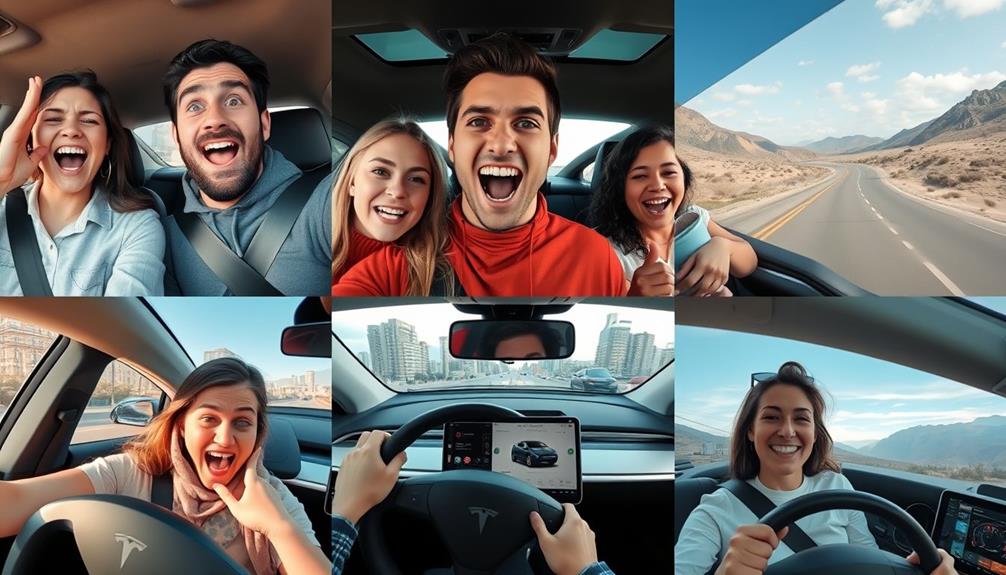
User experiences with Full Self-Driving (FSD) are varied, reflecting a mix of excitement and skepticism. Many users initially anticipated revolutionary changes in driving the car, but over time, they've expressed mixed sentiment about FSD's value, especially after recent price cuts.
While some drivers appreciate the advanced capabilities, like smoother shifts and improved decision-making in light traffic, others feel it's more of a novelty than a reliable solution, leading to dissatisfaction.
Reports of FSD's unpredictable behavior have raised concerns, with some claiming it resembles the driving style of an inexperienced driver. This unpredictability can make you hesitant to fully trust the system.
As a result, a growing number of drivers are switching from Tesla to other electric vehicle brands, emphasizing how important user experience is in today's market.
While FSD may become more capable over time with updates, the initial impression for many has been disappointing. Users are left wondering if the feature truly lives up to its promise or if it's just an expensive add-on.
As these sentiments evolve, they'll certainly shape the future of FSD and its acceptance among drivers.
Ethical Considerations in FSD
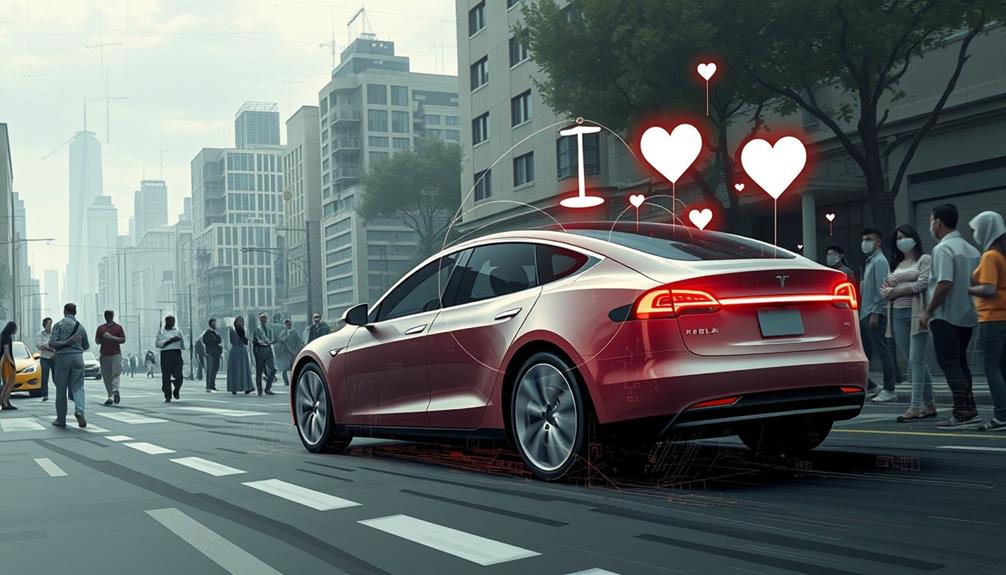
As the debate over Full Self-Driving (FSD) technology continues, ethical considerations emerge as a critical focal point. While Tesla promotes FSD as a leap towards autonomy, it's classified as SAE Level 2 automation, meaning driver supervision remains essential. Misunderstanding this can lead to safety concerns, especially given historical incidents that highlight the system's limitations.
Here are some ethical considerations to ponder:
- Responsibility: Who's accountable in the event of an accident?
- Driver Attentiveness: How does reliance on FSD impact driver engagement?
- Regulatory Oversight: Are safety standards sufficient in the rollout of this technology?
- Transparency: Should Tesla disclose more about FSD's testing and capabilities?
- Human Control: How do we balance technology advancement with the need for human oversight?
These ethical debates challenge you to reflect on the implications of autonomy in driving.
As society navigates this evolving landscape, the balance between embracing innovation and ensuring safety and accountability becomes increasingly important.
After all, with great technology comes great responsibility.
Frequently Asked Questions
Is a Tesla Full Self-Driving Subscription Worth It?
When considering a Tesla Full Self-Driving subscription, evaluate its features against your driving needs. If you value convenience and want to try it risk-free, the trial offers a great opportunity to decide.
What Are the Benefits of Tesla Full Self-Driving?
You’ll enjoy convenience, enhanced safety, and reduced stress with Tesla’s Full Self-Driving. You’ll experience smoother navigation, effortless lane changes, and efficient parking. Plus, it learns and adapts, improving your driving experience over time. With Tesla’s Full Self-Driving, you’ll also have access to Tesla’s dual motor performance benefits, including improved acceleration, traction control, and overall driving dynamics. This means you’ll have increased confidence and control behind the wheel, leading to a more enjoyable and comfortable driving experience. Additionally, the integration of Tesla’s dual motor technology with Full Self-Driving ensures that you have the best combination of safety, convenience, and performance while on the road.
How Much Value Does Full Self-Driving Add to Tesla?
Full Self-Driving adds significant value by enhancing convenience with features like Autopark and Smart Summon. If you drive frequently in urban areas, you'll likely find its capabilities worth the investment, especially with the subscription option.
Does Full Self-Driving Capability Mean It Has Fsd?
Imagine gliding smoothly down the highway; that's what Full Self-Driving promises. However, just because a vehicle has FSD capability doesn't mean it operates independently. You'll still need to keep your hands on the wheel.
Conclusion
So, if you're itching to pay a hefty sum for the privilege of watching your car drive itself—while you sip coffee and scroll through social media—go for it! Just remember, it's not a robot chauffeur; it's more like that overly ambitious friend who insists they can cook but ends up burning toast. We've got the tech, but it's still a work in progress. Enjoy the ride, and keep your hands ready—just in case!





